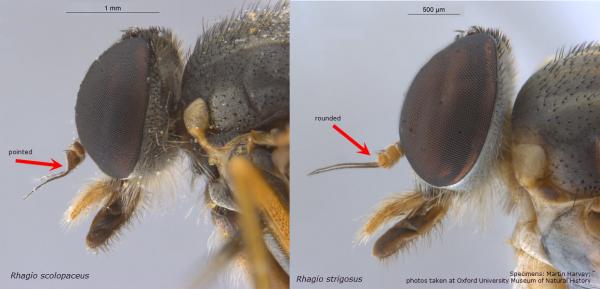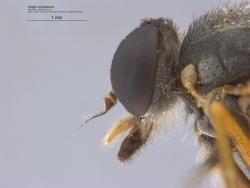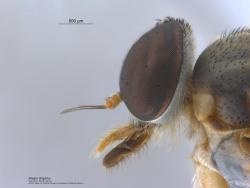The 'downlooker' snipeflies Rhagio scolopaceus and Rhagio strigosus
In Britain there are six species of snipe-fly in genus Rhagio. Four of these species have wings that are clear (apart from a small dark stigma on the wing edge), while two have more extensive dark markings on the wings. These two, Rhagio scolopaceus and Rhagio strigosus, are very similar in general appearance, and it is these that are covered in this guide.
R. scolopaceus is the ‘Downlooker Snipefly’, a very common and widespread species that is often seen sitting on tree trunks and fenceposts, head downwards. R. strigosus, the ‘Yellow Downlooker Snipefly’, is much rarer, with recent records only from Berkshire, Oxfordshire and Surrey, although it can be abundant where it does occur. Larvae are found in the soil, but the life-histories of these two species are not well-known.
The safest way of distinguishing the two species is to check the tip of the third segment of the antenna: in R. scolopaceus this segment has a pointed tip, in R. strigosus it has a rounded tip (click to expand image):
There are some other differences that can give clues as to which species you have, but these are not as reliable as the antennae:
| R. scolopaceus | R. strigosus | |
|---|---|---|
| Sides of thorax | grey | grey or yellowish in strigosus (females are usually yellower than males) |
| Abdomen segment 4 (tergite 4) | long hairs on sides | short hairs on sides |
| Main flight periond | early May to early August, peak in early June | early June to early September, peaking in early July |
See also Steven Falk's Flickr collection for Rhagionidae and Mark Van Veen's online key to family Rhagionidae (includes non-UK species).
Where to look
Rhagio scolopaceus is a widespread and common species in most of Britain. It is found in a wide range of habitats, wherever there is a mix of grassland, scrub and woodland. The adults often sit on tree trunks, head pointing downwards in 'downlooker' pose.
Rhagio strigosus is much rarer, with confirmed records only from chalk habitats in Surrey, Berkshire and Oxfordshire. These include grassland, scrub, woodland edge and arable fields (where it has been seen in large numbers congregating around a telegraph pole). Where it occurs it can be abundant, with aggregations of 100 or more males together (R. scolopaceus seems not to occur in such large groups). R. strigosus also seems to have a tendency to land on bare arms or legs if you walk past one of its regular posts, which I've not experienced with R. scolopaceus..
Higher resolution images:
Thanks to James Hogan of Oxford University Museum of Natural History for help with photo-stacking for these images.



